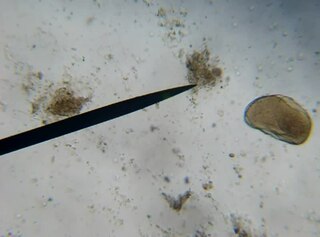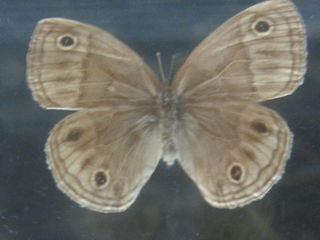Related Research Articles

The opalines are a small group of peculiar heterokonts, currently assigned to the family Opalinidae, in the order Slopalinida. Their name is derived from the opalescent appearance of these microscopic organisms when illuminated with full sunlight. Most opalines live as endocommensals in the large intestine and cloaca of anurans, though they are sometimes found in fish, reptiles, molluscs and insects. The unusual features of the opalines, first observed by Antoine van Leeuwenhoek in 1683, has led to much debate regarding their phylogenetic position among the protists.

Opalina is a genus of parasitic heterokonts found in the intestines of frogs and toads. They lack mouths and contractile vacuoles, they are covered with nearly equal flagelliform cilia, and they have numerous nuclei, all similar. All the species are obligate endosymbionts, most likely commensal rather than parasitic, in cold-blooded vertebrates. Its body is leaflike in shape. They lack cytostomes. They are saprozoic, consuming dead matter, which suggests their commensal role. They propagate by means of plasmotomy. The body is flattened, leaf-like and oval in outline and covered by thin pellicle. Nutrition is by pinocytosis. there are several small, spherical and similar sized nuclei present in the endoplasm. The nuclei are evenly distributed. the animal reproduces by longitudinal and transverse binary fission. it also shows reproduction by plasmotomy in which the cell division is repeated again and again without division of nuclei.the daughter cells encysted and pass out in the faecal matter of the host.
Mesalia opalina is a species of sea snail, a marine gastropod mollusk in the family Turritellidae.

Palaeonympha is a monotypic butterfly genus of the subfamily Satyrinae in the family Nymphalidae. Its one species, Palaeonympha opalina, is found in Taiwan and China.

Calophasia opalina is a moth of the family Noctuidae first described by Eugenius Johann Christoph Esper in 1793. It is found from Southern Europe to Central Asia.

Onciderini is a tribe of longhorn beetles of the subfamily Lamiinae, they are prevalent across Europe in nations such as Turkey, and Finland.
Hypsioma is a genus of longhorn beetles of the subfamily Lamiinae, containing the following species:
Hypsioma amydon is a species of beetle in the family Cerambycidae. It was described by Dillon and Dillon in 1945. It is known from Brazil, Peru and Ecuador.
Hypsioma aristonia is a species of beetle in the family Cerambycidae. It was described by Dillon and Dillon in 1945. It is known from Brazil.
Hypsioma attalia is a species of beetle in the family Cerambycidae. It was described by Dillon and Dillon in 1945. It is known from Brazil.
Hypsioma chapadensis is a species of beetle in the family Cerambycidae. It was described by Dillon and Dillon in 1945. It is known from Brazil and Paraguay.
Hypsioma charila is a species of beetle in the family Cerambycidae. It was described by Dillon and Dillon in 1945. It is known from Brazil.
Hypsioma hezia is a species of beetle in the family Cerambycidae. It was described by Dillon and Dillon in 1945. It is known from Paraguay, Brazil and Argentina.
Hypsioma lyca is a species of beetle in the family Cerambycidae. It was described by Dillon and Dillon in 1945. It is known from Brazil, Colombia, Ecuador and Peru.
Hypsioma nesiope is a species of beetle in the family Cerambycidae. It was described by Dillon and Dillon in 1945. It is known from Colombia and Panama.
Hypsioma rimosa is a species of beetle in the family Cerambycidae. It was described by Dillon and Dillon in 1945. It is known from Paraguay.
Hypsioma robusta is a species of beetle in the family Cerambycidae. It was described by Dillon and Dillon in 1945. It is known from Brazil.
Hypsioma steinbachi is a species of beetle in the family Cerambycidae. It was described by Dillon and Dillon in 1945. It is known from Bolivia and Brazil.
Hypsioma gibbera is a species of beetle in the family Cerambycidae. It was described by Audinet-Serville in 1835. It is known from Argentina, Brazil and Paraguay.
Hypsioma viridis is a species of beetle in the family Cerambycidae. It was described by E. Forrest Gilmour in 1950. It is known from Brazil.
References
- ↑ BioLib.cz - Hypsioma opalina. Retrieved on 8 September 2014.